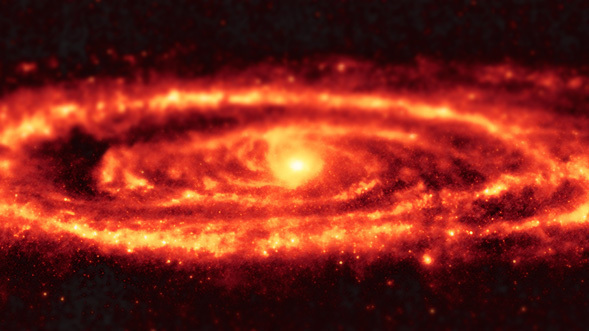Deborah Levine came to IPAC in 1989 with an M.S. in Physics from University of Washington and a B.S. in Physics from UNC-Chapel Hill. She initially held the enigmatic job title “Superfriend” and supported guest investigators using data from the Infrared Astronomical Satellite (IRAS). She earned a Ph.D. in Astronomy from UCLA in 1995 while continuing to work at IPAC in science user support. (She does not recommend this approach to her students.) Her dissertation combined infrared and radio astronomy, studying water masers in the inner regions of the Milky Way Galaxy, but her current research interests are focused on Astronomy Education research.
After completing her Ph.D. defense, she went to Spain in the role of US Resident Astronomer for the Infrared Space Observatory and returned to IPAC in 1998 to work on the Spitzer Space Telescope, then known as SIRTF (Space InfraRed Telescope Facility), initially as the Science Center Science Operations Planner. She worked closely with other Spitzer Science Center teams and with JPL and industry partners to develop interfaces, processes and procedures for Science User Support, Observatory Planning and Scheduling, Pipeline Operations, and Science Data Quality Assessment. She worked on the In-Orbit Checkout plan, and later staffed and managed the Observatory Planning and Scheduling Team, Pipeline Operations Team and Data Quality Assessment Team, and was a member of the Spitzer Anomaly Response Team during operations. She began teaching an evening class at Glendale Community College and discovered she has a genuine passion for teaching astronomy. She left IPAC in November 2012 and is currently teaching full time as Assistant Professor of Astronomy at the nationally recognized Anne Arundel Community College in Arnold, Maryland.
While at UNC-CH, she also completed most of the coursework for a BA in Creative Writing and has recently rediscovered poetry and joined a writer’s group; she should, therefore, be forgiven for submitting her blog post in the form of a double sonnet.

Deborah Levine came to IPAC in 1989 with an M.S. in Physics from University of Washington and a B.S. in Physics from UNC-Chapel Hill. She initially held the enigmatic job title “Superfriend” and supported guest investigators using data from the Infrared Astronomical Satellite (IRAS). She earned a Ph.D. in Astronomy from UCLA in 1995 while continuing to work at IPAC in science user support. (She does not recommend this approach to her students.) Her dissertation combined infrared and radio astronomy, studying water masers in the inner regions of the Milky Way Galaxy, but her current research interests are focused on Astronomy Education research.
After completing her Ph.D. defense, she went to Spain in the role of US Resident Astronomer for the Infrared Space Observatory and returned to IPAC in 1998 to work on the Spitzer Space Telescope, then known as SIRTF (Space InfraRed Telescope Facility), initially as the Science Center Science Operations Planner. She worked closely with other Spitzer Science Center teams and with JPL and industry partners to develop interfaces, processes and procedures for Science User Support, Observatory Planning and Scheduling, Pipeline Operations, and Science Data Quality Assessment. She worked on the In-Orbit Checkout plan, and later staffed and managed the Observatory Planning and Scheduling Team, Pipeline Operations Team and Data Quality Assessment Team, and was a member of the Spitzer Anomaly Response Team during operations. She began teaching an evening class at Glendale Community College and discovered she has a genuine passion for teaching astronomy. She left IPAC in November 2012 and is currently teaching full time as Assistant Professor of Astronomy at the nationally recognized Anne Arundel Community College in Arnold, Maryland.
While at UNC-CH, she also completed most of the coursework for a BA in Creative Writing and has recently rediscovered poetry and joined a writer’s group; she should, therefore, be forgiven for submitting her blog post in the form of a double sonnet.




